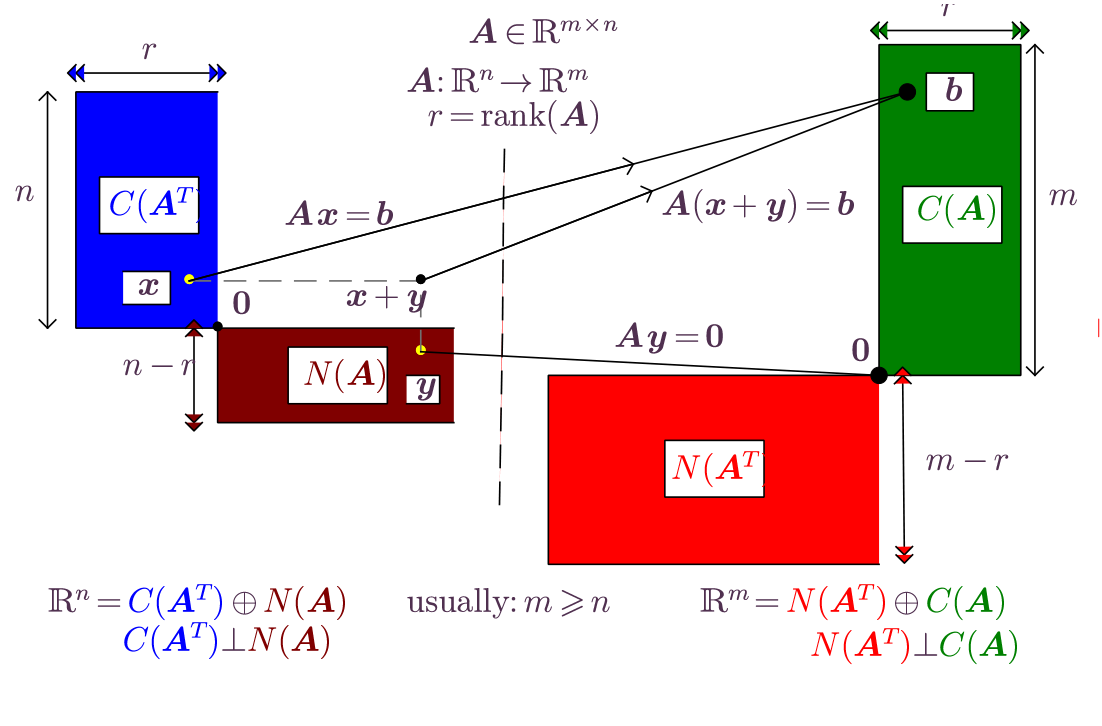Overview
-
FTLA-associated definitions and results
-
Main problems of linear algebra
-
Homework review
-
factorization (Gram-Schmidt algorithm)
-
Projection
-
Least-squares approach to polynomial approximation
-
Set partition =
collection of
disjoint subsets covering the entire set
-
Partitioning of vector spaces: similar allow as a common element
-
,
,
-
Relationships of subspaces associated with
When is a vector space sum a direct sum?
|
|
Lemma 1.
Let ,
be subspaces of vector space .
Then
if and only if
-
,
and
-
.
Proof.
by definition of direct sum, sum of vector subspaces. To prove that
,
consider .
Since
and
write
and since expression
is unique, it results that .
Now assume (i),(ii) and establish an unique decomposition. Assume
there might be two decompositions of ,
,
,
with ,
Obtain ,
or .
Since
and
it results that ,
and ,
,
i.e., the decomposition is unique.
Theorem.
Given the linear mapping associated with
matrix
we have:
-
,
the direct sum of the column space and left null space is the
codomain of the mapping
-
,
the direct sum of the row space and null space is the domain of
the mapping
-
and , the column space is
orthogonal to the left null space, and they are orthogonal
complements of one another,
-
and , the row space is
orthogonal to the null space, and they are orthogonal
complements of one another,
FTLA: a graphical representation
|
|
 |
|
Figure 1. Graphical representation of the
Fundamental Theorem of Linear Algebra, Gil Strang, Amer.
Math. Monthly 100, 848-855, 1993.
|
FTLA proof highlights the properties of a norm, especially .
-
(column space is
orthogonal to left null space).
Proof.
Consider arbitrary .
By definition of ,
such that ,
and by definition of ,
.
Compute ,
hence
for arbitrary ,
and .
-
( is the only vector both in
and ).
Proof.
(By contradiction, reductio ad
absurdum). Assume there might be
and
and .
Since ,
such that .
Since ,
.
Note that
since ,
contradicting assumptions. Multiply equality
on left by ,
thereby obtaining ,
using norm property 3. Contradiction.
-
established that
are orthogonal complements
By Lemma 2 it results that .
-
Second part of FTLA: as above for
FTLA: useful concepts and results
|
|
Definition.
The rank of matrix
is the dimension of the column space,
Definition.
The nullity of
is the dimension of the null space,
Proposition.
The dimension of the column space equals the
dimension of the row space.
Corollary.
The system ,
,
,
has a solution if .
The solution is unique if .
Definition.
The Dirac delta symbol
is defined as
Definition.
A set of vectors is said to be orthonormal
if
Matrix formulation of Gram-Schmidt (
factorization)
|
|
-
Consider
with linearly independent columns. By linear combinations of the
columns of a
set of orthonormal vectors
will be obtained. This can be expressed as a matrix product
with ,
.
The matrix
is upper-triangular (also referred to as right-triangular) since
to find vector
only vector
is used, to find vector
only vectors
are used
-
The above is equivalent to the system
Matrix formulation of Gram-Schmidt (
factorization)
|
|
Given vectors
Initialize ,..,,
;
;
-
For
with linearly independent columns, the Gram-Schmidt algorithm
furnishes a factorization
with
with orthonormal columns and
an upper triangular matrix.
-
Since the column vectors within
were obtained through linear combinations of the column vectors of
we have
Orthogonal projection of a vector along another vector
|
|

Definition.
The orthogonal
projection of
along direction ,
is the
vector .
-
Scalar-vector multiplication commutativity:
-
Matrix multiplication associativity: ,
with
Definition.
The matrix
is the orthogonal projector along direction ,
.
Orthogonal projection onto a subspace
|
|

Definition.
The orthogonal projector
onto ,
with orthonormal column vectors is
Complementary orthogonal projector
|
|
Definition.
The complementary orthogonal
projector to
is ,
where
is a matrix with orthonormal columns.
Orthogonal projectors and linear systems
|
|
-
Consider the linear system
with ,
,
.
Orthogonal projectors and knowledge of the four fundamental matrix
subspaces allows us to succintly express whether there exist no
solutions, a single solution of an infinite number of solutions:
-
Consider the factorization ,
the orthogonal projector ,
and the complementary orthogonal projector
-
If ,
then has
a component outside the column space of , and
has no solution
-
If ,
then
and the system has at least one solution
-
If (null space only
contains the zero vector, i.e., null space of dimension 0) the
system has a unique solution
-
If ,
then a vector
in the null space is written as
and if
is a solution of ,
so is ,
since
The linear system has an -parameter
family of solutions
Least squares: linear regression calculus approach
|
|
-
In many scientific fields the problem of determining the straight
line ,
that best approximate data arises. The problem is to
find the coefficients ,
and this is referred to as the linear regression
problem.
-
The calculus approach: Form sum of squared differences between
and
and seek that minimize by solving the equations
Geometry of linear regression
|
|
-
Form a vector of errors with components .
Recognize that
is a linear combination of
and
with coefficients ,
or in vector form
-
The norm of the error vector
is smallest when
is as close as possible to .
Since
is within the column space of ,
,
the required condition is for
to be orthogonal to the column space






